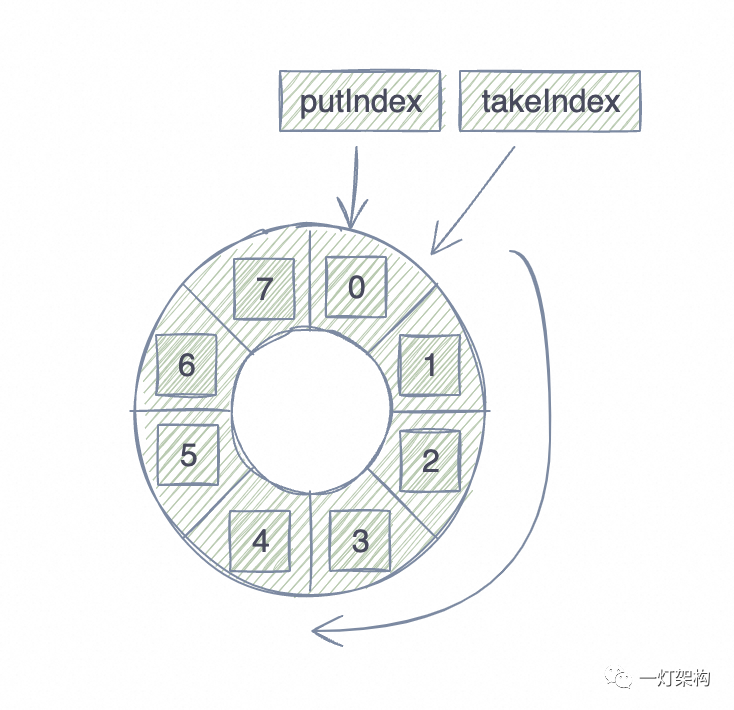引言
在日常开发中,我们好像很少用到BlockingQueue(阻塞队列),BlockingQueue到底有什么作用?应用场景是什么样的?
如果使用过线程池或者阅读过线程池源码,就会知道线程池的核心功能都是基于BlockingQueue实现的。
大家用过消息队列(MessageQueue),就知道消息队列作用是解耦、异步、削峰。同样BlockingQueue的作用也是这三种,区别是BlockingQueue只作用于本机器,而消息队列相当于分布式BlockingQueue。
BlockingQueue作为阻塞队列,主要应用于生产者-消费者模式的场景,在并发多线程中尤其常用。
- 比如像线程池中的任务调度场景,提交任务和拉取并执行任务。
- 生产者与消费者解耦的场景,生产者把数据放到队列中,消费者从队列中取数据进行消费。两者进行解耦,不用感知对方的存在。
- 应对突发流量的场景,业务高峰期突然来了很多请求,可以放到队列中缓存起来,消费者以正常的频率从队列中拉取并消费数据,起到削峰的作用。
BlockingQueue是个接口,定义了几组放数据和取数据的方法,来满足不同的场景。
操作 | 抛出异常 | 返回特定值 | 阻塞 | 阻塞一段时间 |
放数据 | add() | offer() | put() | offer(e, time, unit) |
取数据(同时删除数据) | remove() | poll() | take() | poll(time, unit) |
取数据(不删除) | element() | peek() | 不支持 | 不支持 |
BlockingQueue有5个常见的实现类,应用场景不同。
- ArrayBlockingQueue
基于数组实现的阻塞队列,创建队列时需指定容量大小,是有界队列。
- LinkedBlockingQueue
基于链表实现的阻塞队列,默认是无界队列,创建可以指定容量大小
- SynchronousQueue
一种没有缓冲的阻塞队列,生产出的数据需要立刻被消费
- PriorityBlockingQueue
实现了优先级的阻塞队列,基于数据显示,是无界队列
- DelayQueue
实现了延迟功能的阻塞队列,基于PriorityQueue实现的,是无界队列
今天重点讲一下ArrayBlockingQueue的底层实现原理,在接下来的文章中再讲一下其他队列实现。
ArrayBlockingQueue类结构
先看一下ArrayBlockingQueue类里面有哪些属性:
public class ArrayBlockingQueue<E>
extends AbstractQueue<E>
implements BlockingQueue<E>, java.io.Serializable {
/**
* 用来存放数据的数组
*/
final Object[] items;
/**
* 下次取数据的数组下标位置
*/
int takeIndex;
/**
* 下次放数据的数组下标位置
*/
int putIndex;
/**
* 元素个数
*/
int count;
/**
* 独占锁,用来保证存取数据安全
*/
final ReentrantLock lock;
/**
* 取数据的条件
*/
private final Condition notEmpty;
/**
* 放数据的条件
*/
private final Condition notFull;
}可以看出ArrayBlockingQueue底层是基于数组实现的,使用对象数组items存储元素。为了实现队列特性(一端插入,另一端删除),定义了两个指针,takeIndex表示下次取数据的位置,putIndex表示下次放数据的位置。 另外ArrayBlockingQueue还使用ReentrantLock保证线程安全,并且定义了两个条件,当条件满足的时候才允许放数据或者取数据,下面会详细讲。
初始化
ArrayBlockingQueue常用的初始化方法有两个:
- 指定容量大小
- 指定容量大小和是否是公平锁
/**
* 指定容量大小的构造方法
*/
BlockingQueue<Integer> blockingDeque1 = new ArrayBlockingQueue<>(1);
/**
* 指定容量大小、公平锁的构造方法
*/
BlockingQueue<Integer> blockingDeque1 = new ArrayBlockingQueue<>(1, true);再看一下对应的源码实现:
/**
* 指定容量大小的构造方法(默认是非公平锁)
*/
public ArrayBlockingQueue(int capacity) {
this(capacity, false);
}
/**
* 指定容量大小、公平锁的构造方法
*
* @param capacity 数组容量
* @param fair 是否是公平锁
*/
public ArrayBlockingQueue(int capacity, boolean fair) {
if (capacity <= 0) {
throw new IllegalArgumentException();
}
this.items = new Object[capacity];
lock = new ReentrantLock(fair);
notEmpty = lock.newCondition();
notFull = lock.newCondition();
}放数据源码
放数据的方法有四个:
操作 | 抛出异常 | 返回特定值 | 阻塞 | 阻塞一段时间 |
放数据 | add() | offer() | put() | offer(e, time, unit) |
offer方法源码
先看一下offer()方法源码,其他方法逻辑也是大同小异。 无论是放数据还是取数据,都是从队头开始,向队尾移动。
 图片
图片
/**
* offer方法入口
*
* @param e 元素
* @return 是否插入成功
*/
public boolean offer(E e) {
// 1. 判空,传参不允许为null
checkNotNull(e);
// 2. 加锁
final ReentrantLock lock = this.lock;
lock.lock();
try {
// 3. 判断数组是否已满,如果满了就直接返回false结束
if (count == items.length) {
return false;
} else {
// 4. 否则就插入
enqueue(e);
return true;
}
} finally {
// 5. 释放锁
lock.unlock();
}
}
/**
* 入队
*
* @param x 元素
*/
private void enqueue(E x) {
// 1. 获取数组
final Object[] items = this.items;
// 2. 直接放入数组
items[putIndex] = x;
// 3. 移动putIndex位置,如果到达数组的末尾就从头开始
if (++putIndex == items.length) {
putIndex = 0;
}
// 4. 计数
count++;
// 5. 唤醒因为队列为空,等待取数据的线程
notEmpty.signal();
}offer()在数组满的时候,会返回false,表示添加失败。 为了循环利用数组,添加元素的时候如果已经到了队尾,就从队头重新开始,相当于一个循环队列,像下面这样:
 图片
图片
add方法源码
再看一下另外三个添加元素方法源码: add()方法在数组满的时候,会抛出异常,底层基于offer()实现。
/**
* add方法入口
*
* @param e 元素
* @return 是否添加成功
*/
public boolean add(E e) {
if (offer(e)) {
return true;
} else {
throw new IllegalStateException("Queue full");
}
}put方法源码
put()方法在数组满的时候,会一直阻塞,直到有其他线程取走数据,空出位置,才能添加成功。
/**
* put方法入口
*
* @param e 元素
*/
public void put(E e) throws InterruptedException {
// 1. 判空,传参不允许为null
checkNotNull(e);
// 2. 加可中断的锁,防止一直阻塞
final ReentrantLock lock = this.lock;
lock.lockInterruptibly();
try {
// 3. 如果队列已满,就一直阻塞,直到被唤醒
while (count == items.length) {
notFull.await();
}
// 4. 如果队列未满,直接入队
enqueue(e);
} finally {
// 5. 释放锁
lock.unlock();
}
}offer(e, time, unit)源码
再看一下offer(e, time, unit)方法源码,在数组满的时候, offer(e, time, unit)方法会阻塞一段时间。
/**
* offer方法入口
*
* @param e 元素
* @param timeout 超时时间
* @param unit 时间单位
* @return 是否添加成功
*/
public boolean offer(E e, long timeout, TimeUnit unit) throws InterruptedException {
// 1. 判空,传参不允许为null
checkNotNull(e);
// 2. 把超时时间转换为纳秒
long nanos = unit.toNanos(timeout);
// 3. 加可中断的锁,防止一直阻塞
final ReentrantLock lock = this.lock;
lock.lockInterruptibly();
try {
// 4. 循环判断队列是否已满
while (count == items.length) {
if (nanos <= 0) {
// 6. 如果队列已满,且超时时间已过,则返回false
return false;
}
// 5. 如果队列已满,则等待指定时间
nanos = notFull.awaitNanos(nanos);
}
// 7. 如果队列未满,则入队
enqueue(e);
return true;
} finally {
// 8. 释放锁
lock.unlock();
}
}弹出数据源码
弹出数据(取出数据并删除)的方法有四个:
操作 | 抛出异常 | 返回特定值 | 阻塞 | 阻塞一段时间 |
取数据(同时删除数据) | remove() | poll() | take() | poll(time, unit) |
poll方法源码
看一下poll()方法源码,其他方法逻辑大同小异。 poll()方法在弹出元素的时候,如果数组为空,则返回null,表示弹出失败。
/**
* poll方法入口
*/
public E poll() {
// 1. 加锁
final ReentrantLock lock = this.lock;
lock.lock();
try {
// 2. 如果数组为空,则返回null,否则返回队列头部元素
return (count == 0) ? null : dequeue();
} finally {
// 3. 释放锁
lock.unlock();
}
}
/**
* 出列
*/
private E dequeue() {
// 1. 取出队列头部元素
final Object[] items = this.items;
E x = (E) items[takeIndex];
// 2. 取出元素后,把该位置置空
items[takeIndex] = null;
// 3. 移动takeIndex位置,如果到达数组的末尾就从头开始
if (++takeIndex == items.length) {
takeIndex = 0;
}
// 4. 元素个数减一
count--;
if (itrs != null) {
itrs.elementDequeued();
}
// 5. 唤醒因为队列已满,等待放数据的线程
notFull.signal();
return x;
}可见取数据跟放数据一样,都是循环遍历数组。
remove方法源码
再看一下remove()方法源码,如果数组为空,remove()会抛出异常。
/**
* remove方法入口
*/
public E remove() {
// 1. 直接调用poll方法
E x = poll();
// 2. 如果取到数据,直接返回,否则抛出异常
if (x != null) {
return x;
} else {
throw new NoSuchElementException();
}
}take方法源码
再看一下take()方法源码,如果数组为空,take()方法就一直阻塞,直到被唤醒。
/**
* take方法入口
*/
public E take() throws InterruptedException {
// 1. 加可中断的锁,防止一直阻塞
final ReentrantLock lock = this.lock;
lock.lockInterruptibly();
try {
// 2. 如果数组为空,就一直阻塞,直到被唤醒
while (count == 0) {
notEmpty.await();
}
// 3. 如果数组不为空,就从数组中取数据
return dequeue();
} finally {
// 4. 释放锁
lock.unlock();
}
}poll(time, unit)源码
再看一下poll(time, unit)方法源码,在数组满的时候, poll(time, unit)方法会阻塞一段时间。
/**
* poll方法入口
*
* @param timeout 超时时间
* @param unit 时间单位
* @return 元素
*/
public E poll(long timeout, TimeUnit unit) throws InterruptedException {
// 1. 把超时时间转换成纳秒
long nanos = unit.toNanos(timeout);
// 2. 加可中断的锁,防止一直阻塞
final ReentrantLock lock = this.lock;
lock.lockInterruptibly();
try {
// 3. 如果数组为空,就开始阻塞
while (count == 0) {
if (nanos <= 0) {
// 5. 如果数组为空,且超时时间已过,则返回null
return null;
}
// 4. 阻塞到到指定时间
nanos = notEmpty.awaitNanos(nanos);
}
// 6. 如果数组不为空,则出列
return dequeue();
} finally {
// 7. 释放锁
lock.unlock();
}
}查看数据源码
再看一下查看数据源码,查看数据,并不删除数据。
操作 | 抛出异常 | 返回特定值 | 阻塞 | 阻塞一段时间 |
取数据(不删除) | element() | peek() | 不支持 | 不支持 |
peek方法源码
先看一下peek()方法源码,如果数组为空,就返回null。
/**
* peek方法入口
*/
public E peek() {
// 1. 加锁
final ReentrantLock lock = this.lock;
lock.lock();
try {
// 2. 返回数组头部元素,如果数组为空,则返回null
return itemAt(takeIndex);
} finally {
// 3. 释放锁
lock.unlock();
}
}
/**
* 返回当前位置元素
*/
final E itemAt(int i) {
return (E) items[i];
}element方法源码
再看一下element()方法源码,如果数组为空,则抛出异常。
/**
* element方法入口
*/
public E element() {
// 1. 调用peek方法查询数据
E x = peek();
// 2. 如果查到数据,直接返回
if (x != null) {
return x;
} else {
// 3. 如果没找到,则抛出异常
throw new NoSuchElementException();
}
}总结
这篇文章讲解了ArrayBlockingQueue队列的核心源码,了解到ArrayBlockingQueue队列具有以下特点:
- ArrayBlockingQueue实现了BlockingQueue接口,提供了四组放数据和读数据的方法,来满足不同的场景。
- ArrayBlockingQueue底层基于数组实现,采用循环数组,提升了数组的空间利用率。
- ArrayBlockingQueue初始化的时候,必须指定队列长度,是有界的阻塞队列,所以要预估好队列长度,保证生产者和消费者速率相匹配。
- ArrayBlockingQueue的方法是线程安全的,使用ReentrantLock在操作前后加锁来保证线程安全。
今天一起分析了ArrayBlockingQueue队列的源码,可以看到ArrayBlockingQueue的源码非常简单,没有什么神秘复杂的东西,下篇文章再一起接着分析其他的阻塞队列源码。


































